The Mobile Threat Management Security Software Market is estimated to be valued at USD 7.1 billion in 2025 and is projected to reach USD 33.0 billion by 2035, registering a compound annual growth rate (CAGR) of 16.5% over the forecast period.
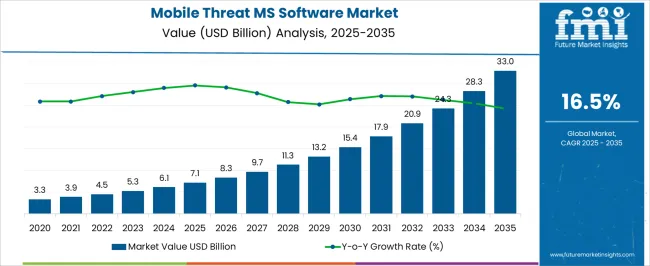
| Metric | Value |
|---|---|
| Mobile Threat Management Security Software Market Estimated Value in (2025 E) | USD 7.1 billion |
| Mobile Threat Management Security Software Market Forecast Value in (2035 F) | USD 33.0 billion |
| Forecast CAGR (2025 to 2035) | 16.5% |
The mobile threat management security software market is expanding rapidly as enterprises and individuals face escalating risks from malware, phishing, ransomware, and unauthorized data access. The growing use of mobile devices for financial transactions, corporate communication, and cloud access has heightened the need for advanced threat detection and prevention solutions.
Regulatory requirements around data protection and privacy are compelling organizations to strengthen their mobile security infrastructure. Continuous advancements in AI driven analytics, real time monitoring, and automated response capabilities are further enhancing the reliability and adoption of these solutions.
The outlook for the market remains strong as both businesses and individuals prioritize robust mobile security frameworks to safeguard digital assets, ensure compliance, and maintain trust in increasingly interconnected digital ecosystems.
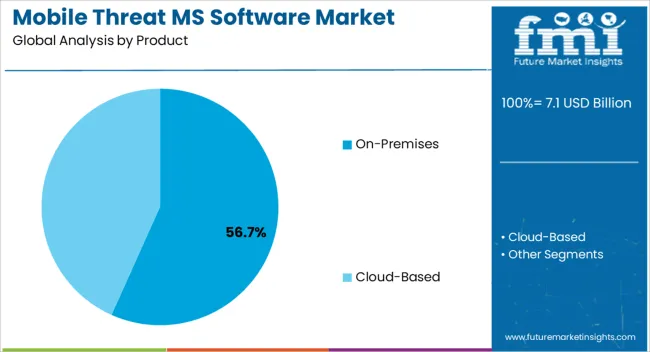
The on premises segment is expected to account for 56.70% of total revenue by 2025, positioning it as the dominant product category. Its leadership is attributed to organizations’ preference for maintaining control over sensitive data and critical infrastructure within their own environments.
Industries with strict regulatory requirements and high security concerns, such as finance, defense, and healthcare, have shown strong reliance on on premises deployment models. Enhanced ability to customize, monitor, and manage security configurations has further reinforced adoption.
As data breaches grow more sophisticated, enterprises continue to favor solutions that provide full control and integration with internal IT systems, strengthening the position of the on premises segment.
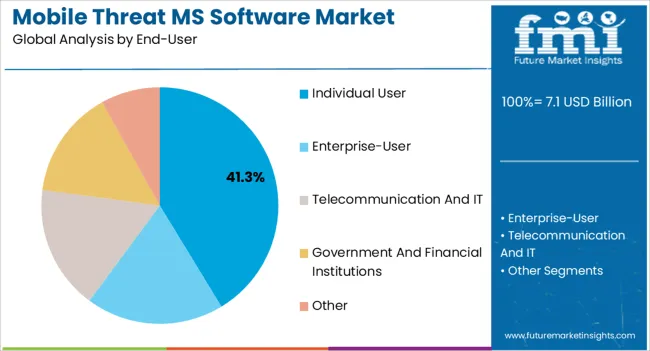
The individual user segment is projected to represent 41.30% of the total market by 2025, making it the leading end user group. This growth is being fueled by rising personal dependency on mobile devices for financial transactions, social communication, and online services.
The growing prevalence of mobile based cyber threats such as phishing, spyware, and identity theft has accelerated the need for user friendly and affordable security solutions. Increased awareness of data privacy risks and availability of accessible subscription based security platforms are further driving adoption.
As mobile device penetration deepens globally, individuals are increasingly investing in advanced security tools, consolidating their share as the largest end user segment.
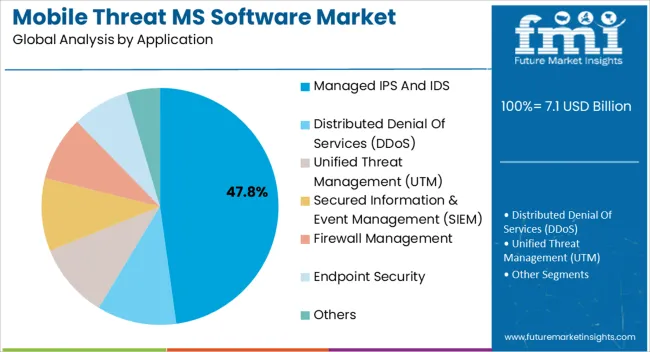
The managed IPS and IDS segment is set to hold 47.80% of total revenue by 2025 within the application category, making it the leading segment. The dominance is supported by the rising demand for proactive security solutions capable of detecting and preventing network intrusions in real time.
Managed IPS and IDS systems provide continuous monitoring, immediate threat response, and comprehensive visibility into mobile network vulnerabilities. Organizations facing resource and skill shortages have increasingly turned to managed service models for cost effective and reliable protection.
The ability of these solutions to scale, adapt, and integrate with evolving mobile ecosystems has cemented their role as the preferred application area, ensuring their sustained leadership within the mobile threat management security software market.
There is a rising frequency of cyber-attacks that are serving as the primary factor behind driving the expansion of the mobile threat management security software market. Cyber-attacks are growing complex and advanced, which is likely to bolster the demand for mobile threat management security software in the upcoming years.
People use online applications now and then these days, due to which the need for mobile threat management security software is continuously increasing to enhance security capabilities to handle both device and network risks associated with the deployment of mobile apps.
Hackers are coming up with novel ways always to steal information and cause havoc for both organizations and individuals. Alongside, the rising usage of social media indeed has boosted several cyber-attacks globally, which is expected to drive the mobile threat management security software market size.
Continuous expansion of consumerization of IT and bring your own device (BYOD) and the challenges related to terms of managing and securing mobile devices and information influencing the demand for the adoption of mobile threat management security software services.
Many applications are downloaded from third-party stores, which may not have good security controls in place. Therefore, to protect businesses against fraud and data breaches, mobile threat management security software is used to detect, analyze, and remediate malware on mobile devices. Further, it is anticipated that the adoption of mobile threat management security software is increasing because it allows mobile workers to use their devices for business without sacrificing privacy.
The end-users in the market are using mobile threat management security software as a result of these concerns, which is fueling the growth of the mobile threat management security software market. However, it is anticipated that the lack of awareness regarding cyber security and vulnerability might act as a restraining factor in the market growth of mobile threat management security software.
There is a distribution of pirated software that acts as a key challenge to the market share of mobile threat management security software. Many people use computers or mobile phones to access untrustworthy websites and download unsafe apps, making these devices exposed to cyber attacks. Further, the market's growth is getting stifled by a lack of understanding regarding mobile device dangers and security solutions.
Technical issues like system and device compatibility are also key restraints that may hamper the growth of the mobile threat management security software market.
Keeping the current market scenario under consideration, North America is anticipated to capture a notable market share in terms of revenue, owing to rapid advancement in the mobile threat management security software market. It is likely to hold 33.6% of the total market share during the forecast period. North America accounted for a market share of 28.6 USD in 2025.
The mobile threat management security software market is likely to be driven by severe government data security requirements, along with IT sector developments in these regions.
The mobile security business is undergoing a substantial change in this region, because of numerous attacks, especially on the health industry, and security measures are being deployed in this region. Regions of Europe are accounting for 21.5% of the global market share for mobile threat management security software services, owing to their high disposable income and usage of online platforms.
The region is expected to have favorable growth in the mobile threat management security software market. The surge of cyber-attacks in the technology sector is expected to drive up the need for security software. Europe market held a market share of 23.2% in 2025.
Even while cyber-attacks affect every industry, certain of the targeted companies confront massive network and web-related harm. Because the IT business is the most dependent on the internet, it faces many cyber-attacks.
Organizational mobility is proven to be beneficial for the implementation of security for smartphones in several public and private enterprises. As a result of many cyberattacks, including web attacks and network attacks, the telecommunications and IT sectors are using mobile application authentication technologies. As an outcome, the telecommunication and IT segment is likely to increase significantly in the coming years. This segment held a market share of 28.9% in 2025.
The cloud-based segment held a 57% market share. The cloud servers administer cloud-based mobile threat security solutions. It doesn't need to be installed on users' devices; rather, it may be obtained using particular user login details; smartphone users may utilize MTMSS via the internet using a web-based app.
Cloud-based MTMSS allows users to choose the best plan for their needs, resulting in affordability, flexibility, connectivity, and sophisticated security features. As a result, the aforementioned variables are likely to drive market demand in the defined category.
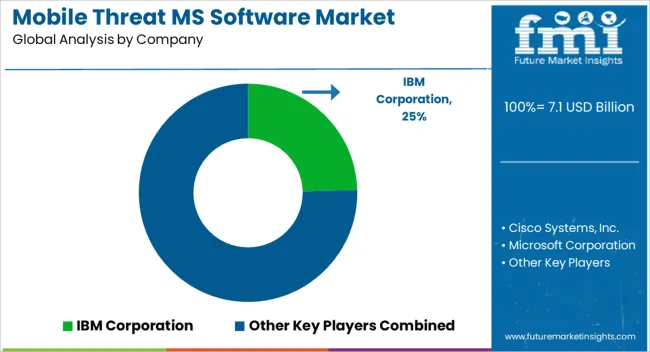
Some of the key players working in the mobile threat management security software market are IBM Corporation, Cisco Systems, Inc., Microsoft Corporation, Intel Corporation, BullGuard Ltd., Dell Inc., Absolute Software Corporation, SAP AG, Symantec Corporation, MobileIron, Inc., LANDesk Software Inc., Apperian, Inc., and others.
The key players in the market are using the best technology available to curb instances of cyber fraud. Technologies such as Big Data, Machine Learning, and Artificial Intelligence have proven to be leading instruments in dictating cyberattacks.
Key Trends in the Mobile Threat Management Security Software Market
Some of the key trends in the mobile threat management security software market are:
| Report Attribute | Details |
|---|---|
| Growth Rate | CAGR of 17.7% from 2025 to 2035 |
| Base Year for Estimation | 2025 |
| Historical Data | 2020 to 2025 |
| Forecast Period | 2025 to 2035 |
| Mobile Threat Management Security Software Market Value (2025) | USD 5,194.9 million |
| Mobile Threat Management Security Software Market Anticipated Value (2035) | USD 25,691.7 million |
| Quantitative Units | Revenue in USD million, Volume in Kilotons, and CAGR from 2025 to 2035 |
| Report Coverage | Revenue Forecast, Volume Forecast, Company Ranking, Competitive Landscape, Growth Factors, Trends, and Pricing Analysis |
| Segments Covered | Type, Form, End Use, Region |
| Regions Covered | North America; Latin America; Western Europe; Eastern Europe; South Asia and Pacific; East Asia; The Middle East and Africa |
| Key Countries Profiled | The United States, Canada, Brazil, Mexico, Germany, The United Kingdom, France, Spain, Italy, Poland, Russia, Czech Republic, Romania, India, Bangladesh, Australia, New Zealand, China, Japan, South Korea, GCC Countries, South Africa, Israel |
| Key Companies Profiled | IBM Corporation; Cisco Systems, Inc.; Microsoft Corporation; Intel Corporation; BullGuard Ltd.; Dell Inc.; Absolute Software Corporation; SAP AG; Symantec Corporation; MobileIron, Inc.; LANDesk Software Inc.; Apperian, Inc.; Other |
| Customization | Available Upon Request |
The global mobile threat management security software market is estimated to be valued at USD 7.1 billion in 2025.
The market size for the mobile threat management security software market is projected to reach USD 33.0 billion by 2035.
The mobile threat management security software market is expected to grow at a 16.5% CAGR between 2025 and 2035.
The key product types in mobile threat management security software market are on-premises and cloud-based.
In terms of end-user, individual user segment to command 41.3% share in the mobile threat management security software market in 2025.






Our Research Products

The "Full Research Suite" delivers actionable market intel, deep dives on markets or technologies, so clients act faster, cut risk, and unlock growth.

The Leaderboard benchmarks and ranks top vendors, classifying them as Established Leaders, Leading Challengers, or Disruptors & Challengers.

Locates where complements amplify value and substitutes erode it, forecasting net impact by horizon

We deliver granular, decision-grade intel: market sizing, 5-year forecasts, pricing, adoption, usage, revenue, and operational KPIs—plus competitor tracking, regulation, and value chains—across 60 countries broadly.

Spot the shifts before they hit your P&L. We track inflection points, adoption curves, pricing moves, and ecosystem plays to show where demand is heading, why it is changing, and what to do next across high-growth markets and disruptive tech

Real-time reads of user behavior. We track shifting priorities, perceptions of today’s and next-gen services, and provider experience, then pace how fast tech moves from trial to adoption, blending buyer, consumer, and channel inputs with social signals (#WhySwitch, #UX).

Partner with our analyst team to build a custom report designed around your business priorities. From analysing market trends to assessing competitors or crafting bespoke datasets, we tailor insights to your needs.
Supplier Intelligence
Discovery & Profiling
Capacity & Footprint
Performance & Risk
Compliance & Governance
Commercial Readiness
Who Supplies Whom
Scorecards & Shortlists
Playbooks & Docs
Category Intelligence
Definition & Scope
Demand & Use Cases
Cost Drivers
Market Structure
Supply Chain Map
Trade & Policy
Operating Norms
Deliverables
Buyer Intelligence
Account Basics
Spend & Scope
Procurement Model
Vendor Requirements
Terms & Policies
Entry Strategy
Pain Points & Triggers
Outputs
Pricing Analysis
Benchmarks
Trends
Should-Cost
Indexation
Landed Cost
Commercial Terms
Deliverables
Brand Analysis
Positioning & Value Prop
Share & Presence
Customer Evidence
Go-to-Market
Digital & Reputation
Compliance & Trust
KPIs & Gaps
Outputs
Full Research Suite comprises of:
Market outlook & trends analysis
Interviews & case studies
Strategic recommendations
Vendor profiles & capabilities analysis
5-year forecasts
8 regions and 60+ country-level data splits
Market segment data splits
12 months of continuous data updates
DELIVERED AS:
PDF EXCEL ONLINE
Mobile Camping Toilet Market Size and Share Forecast Outlook 2025 to 2035
Mobile Phone Screen Underlayer Cushioning Material Market Size and Share Forecast Outlook 2025 to 2035
Mobile Application Store Market Size and Share Forecast Outlook 2025 to 2035
Mobile Money Market Forecast and Outlook 2025 to 2035
Mobile Application Testing Solution Market Size and Share Forecast Outlook 2025 to 2035
Mobile Cardiac Telemetry System Market Size and Share Forecast Outlook 2025 to 2035
Mobile Robots Market Size and Share Forecast Outlook 2025 to 2035
Mobile Crane Market Size and Share Forecast Outlook 2025 to 2035
Mobile Vascular Imaging Market Size and Share Forecast Outlook 2025 to 2035
Mobile Animal Inhalation Anesthesia Machine Market Size and Share Forecast Outlook 2025 to 2035
Mobile Unified Communications and Collaboration (UC&C) Solution Market Size and Share Forecast Outlook 2025 to 2035
Mobile Data Protection Market Size and Share Forecast Outlook 2025 to 2035
Mobile Medical Tablets Market Size and Share Forecast Outlook 2025 to 2035
Mobile WLAN Access Points Market Size and Share Forecast Outlook 2025 to 2035
Mobile Social Networks Market Size and Share Forecast Outlook 2025 to 2035
Mobile Printer Market Size and Share Forecast Outlook 2025 to 2035
Mobile Application Development Platform Market Size and Share Forecast Outlook 2025 to 2035
Mobile Broadband Infrastructure Market Size and Share Forecast Outlook 2025 to 2035
Mobile Enterprise Application Development Platform Market Size and Share Forecast Outlook 2025 to 2035
Mobile Analytics Market Size and Share Forecast Outlook 2025 to 2035

Thank you!
You will receive an email from our Business Development Manager. Please be sure to check your SPAM/JUNK folder too.
Chat With
MaRIA